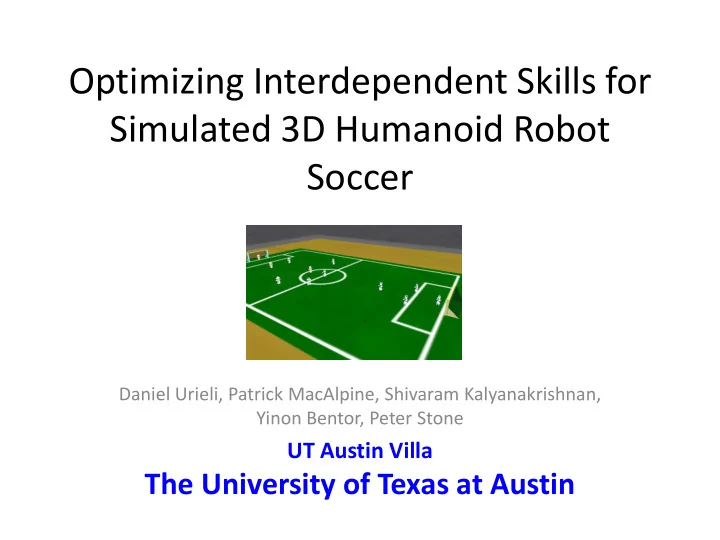

Optimizing Interdependent Skills for Simulated 3D Humanoid Robot Soccer Daniel Urieli, Patrick MacAlpine, Shivaram Kalyanakrishnan, Yinon Bentor, Peter Stone UT Austin Villa The University of Texas at Austin
Goal Creating and integrating a set of motion skills for a 3D simulated robot soccer player
Background • • Simspark simulation 22 degrees of freedom • • Based on ODE engine Communication between agents – 20 bytes messages • Robot model: Aldebaran’s Nao • A robot is operated by joint torques • Message-based interaction with • simulator We wrapped it with a PID controller
Contributions – A skill learning architecture for a humanoid robot soccer agent • Fully deployed in Robocup 2010 • Learning rather than hand-coding more than 100 parameters • A significant building block in our agent, which is competitive with top-8 agents of Robocup 2010 – Sheds light on designing fitness functions for constraining an evolutionary learning process – A new successful application of the CMA-ES algorithm
The Need for A Learning Architecture • Skills needed by a soccer playing robot: Walk-front Walk-back Walk-diagonally Walk-sideways Turn Kick Goalie-dive More… • Coding each skill by hand might be tedious and sub-optimal • On top of it, a skill design need to account for cooperation with other skills – A robot running full speed forwards need to be able to stop and turn without falling…. • Calls for a skill learning architecture
A Framework for Optimization through Learning • Open loop joints control • Repeatedly execute 4 control frames SKILL WALK_FRONT Each frame specifies KEYFRAME 1 reset ARM_LEFT ARM_RIGHT … direct joint angles setTarget JOINT1 $jointvalue1 JOINT2 $jointvalue2 setTarget JOINT3 4.3 JOINT4 52.5 ... wait 0.08 KEYFRAME 2 Skills Description Language ...
Running Massive Amounts of Jobs in Parallel • Our framework uniformly implements several evolutionary algorithms for parameters learning • Evaluations are done in parallel using Condor ( www.cs.wisc.edu/condor ) - an open source software for parallel computing • Repeatedly: Send to condor for real-time fitness Parameters-sets evaluation of parameters population condor Based on the fitness values, create population of the next generation • A complete learning experiment contains 15,000-50,000 runs – For instance, 100 generations x 100 population x 5 averaging runs – Using condor, we run 100 simulations in parallel, 25 seconds per simulation – Wall clock time is 5-7 hours, for a total CPU time of ~ 350 hours
Optimizing individual skills • Goal: optimize the set of joint angles for maximum speed • A fitness of a set of joint angles: The agent’s displacement in the desired direction • Inherently accounts for falls and non-straight walks • Measured over 15 seconds • Extensively compared several learning algorithms: – Hill-Climbing, Cross-Entropy Method, Genetic Algorithm and CMA-ES CMA-ES learning curve
CMA-ES • A stochastic, derivative-free, evolutionary numerical optimization method for non-linear or non-convex problems • Each generation, candidates are sampled from a multidimensional Gaussian, and evaluated for their fitness • Two main principles for parameter adaptation: • Mean maximizes the likelihood of previously successful candidates, Covariance maximizes the likelihood of previously successful search steps (Natural Gradient Decent) • Evolution paths are recorded and used as an information source Found out to be extremely effective in our domain
Results – Individual Skills
Front Walk
Back Walk
Kick
Optimizing Sequences of Skills • Problem: fast locomotion skills, when integrated directly into the robot, result in frequent falls.
Optimizing Sequences of Skills • Problem: fast locomotion skills, when integrated directly into the robot result in frequent falls. • An example skill execution log (32ms decision cycle): Skills are interdependent: Learn them together • Skills dependencies graph:
Idea 1: Optimize skills in conjunction • Want both speed and stability under these transitions: • Change the fitness evaluation method: – Evaluation method should include all skill transitions – But still reflect how good the currently-learned skill is • An ideal fitness evaluation: Full Game results – But too noisy • An effective alternative: – The time-to-score on an empty field – No noise caused by other players – Robot moves in a realistic scenario of skill transitions – Evaluated based on its ultimate objective
A Problem • So far, optimized under these constraints • The need to transition smoothly from every skill to every skill limits our max-speed • Can we relax some constraints, thus achieving faster speeds?
Idea 2: Skill Decoupling • It turns out we can further optimize speed, by adding additional, less-constrained skills. Add new skills, constrained by only one skill
Putting it all together Agent A1 – Agent A2 – Agent A0 – WalkFront_S WalkFront_F initial seed optimized optimized Agent A5 – Agent A4 – Agent A3 – Decision WalkBack_F WalkBack_S thresholds optimized optimized tuned
A0 vs. A5 A0 A5
Results – Agents Improvements Full 6x6 game results
Results – Time-To-Score Measure
Results – Full Games Goal Differential (stderr)
Future Work • Extend the scope of learning within our agent: – Waiting times between frames – Replace hand-coded skills: fine positioning, getting up – Decision thresholds • Alternative parameterizations: closed-loop, inverse kinematics • Extend to real robots?
Related Work • N. Hansen. The CMA Evolution Strategy: A Tutorial, January 2009. • N. Shafii, L. P. Reis, and N. Lao. Biped walking using coronal and sagittal movements based on truncated Fourier series, January 2010. • J. E. Pratt. Exploiting Inherent Robustness and Natural Dynamics in the Control of Bipedal Walking Robots. PhD thesis, Massachusetts Institute of Technology, Cambridge, MA, USA, June 2000. • N. Kohl and P. Stone. Machine learning for fast quadrupedal locomotion, 2004.
Summary • We presented a learning architecture for a simulated humanoid robot soccer player • Optimized over 100 parameters • Used 2 ideas for improving speed while maintaining stability: – Optimizing under constraints – Skills decoupling • A main building block in our agent, which is competitive with Robocup 2010 top-8 teams • Found a new, successful application for the relatively new, CMA-ES algorithm
Recommend
More recommend